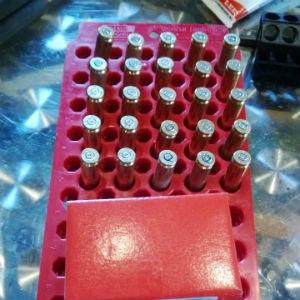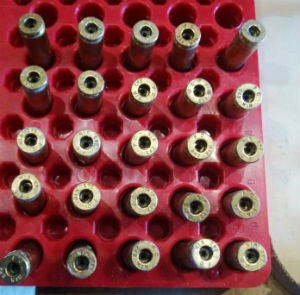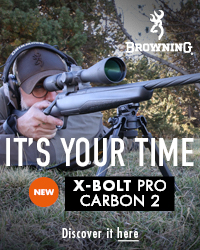Dr Simon Lee has a go at reloading.

Economics drives so much of what we do, I prefer to eat wild venison for an improved diet and health reasons. Can't afford to buy it? Get your own rifle, permission, insurance and away you go. Apart from the cost of consumables, you are all set, having paid for a wall safe, rifle, optics and all the other essentials, and are now probably well into the four figures spent territory.
Each time you pull the trigger it will probably cost you, with factory .243/.308 about £1.75 a round, add to that the cost of a morning's range work with it's ' just one more to check. . . ' pitfall and the cost of ammunition soon mounts up, proving costly in the long run.
 Just how costly was made clear to me as I had a bit of an audit of empty cases, each a lost memory of the £1.75 spent. Something had to be done. Firstly I had to sort out the calibres and inspect them all, any structural damage to the brass or chronic malformity means the case can't be reloaded, finally some time later I had two buckets sorted through.
Just how costly was made clear to me as I had a bit of an audit of empty cases, each a lost memory of the £1.75 spent. Something had to be done. Firstly I had to sort out the calibres and inspect them all, any structural damage to the brass or chronic malformity means the case can't be reloaded, finally some time later I had two buckets sorted through.
Next, still reeling from the sight of what amounted to a bucket full of pound coins, I sorted through the various manufacturers, in my case, Federal, Winchester, and the odd Geco.
All seemed well, no splits or cracks in the cases, at this stage I put the first hundred into some purposed designed reloading trays from MTM, I did have some wild, thrifty notions of bits of plywood and an electric drill before I came to my senses and ordered via Amazon. . .
For really dirty brass cases, an initial cleaning in a tumbler is required, I used a piece of wire wool on my cases, but the tumbler, full of corn cob 'media' and a few drops of special wax cleaner, takes about two hours and makes your cases sparkle like new, if you like that sort of thing. Other methods range from a rub with a brillo pad through to a stainless steel pin wet tumbler that washes the cases to a factory shine.
 So far, so good. Next came the expensive stuff, the various options for presses run from about fifty quid for some manual affair to hundreds of pounds for a mechanised American factory type set up that looks like a starter kit for the third world war.
So far, so good. Next came the expensive stuff, the various options for presses run from about fifty quid for some manual affair to hundreds of pounds for a mechanised American factory type set up that looks like a starter kit for the third world war.
At this point I would like to state that I do not promote one brand over another, what works for me might not work for anyone else and I receive no lucrative sponsorship deal from anyone, more's the pity.
I found the middle ground in a Lee Classic Turret press, this has the upside of keeping all the dies in sequential order and in one place as well as having all the other brochure advantages listed.
The next stage, stage 2 if you're counting, is the lubrication, decapping, and resizing phase. Vitally important here is lubrication prior to resizing, without this the invisible forces that resize the case can get the case stuck in the die, for which I read the manufacturer will charge $6. A light smear on the body of the case will suffice.
Into the two stage die the case goes, the first thing that happens is the spent primer gets poked out from within, supposedly falling into a clear plastic tube hanging below, occasionally flying out into a dark corner of wherever you are doing this to await the vacuum cleaner, on the upstroke the neck is resized to the correct diameter.
 Now the primer pocket needs to be cleaned, this grimy little hole where the primer once sat, needs to be cleaned of the charred residue that can block the flash hole to the main chamber of the case. After a few manual twists doing this, the primer cleaner got fitted into an electric screwdriver to avoid a repetitive strain injury.
Now the primer pocket needs to be cleaned, this grimy little hole where the primer once sat, needs to be cleaned of the charred residue that can block the flash hole to the main chamber of the case. After a few manual twists doing this, the primer cleaner got fitted into an electric screwdriver to avoid a repetitive strain injury.
One down, ninety nine to go.
Stage 3 is case measuring and trimming, another essential part of the process that can't be omitted, as the case has been stretched out it will be lengthened, albeit invisibly. Out comes the digital vernier caliper, obtained for about £15 from the internet. Case trim maximum length and case overall length [COAL, more of which later] are listed on the die instruction sheet. For .308 the maximum trim size is 2.015" or 51.18mm in new money, ignore these numbers and you may cause a jam, or far worse.
Now the turret is rotated 90 degrees and the next die that presents is the case trimming die, a cutter with hand wheel is dropped into the die and after a few gentle turns the case is trimmed to the correct depth, a few tiny specks of brass turning may remain and the case mouth will now be shiny and require chambering and deburring, one double ended tool does this fine adjustment, in reality smoothing off the sharp edge you have just made while trimming.
After a hundred cases trimmed, I swabbed the die out with an earbud to reveal a few crumbs of brass, this represents the invisible stretching of the case during firing and trimming to length, so with my once-fired brass I wasn't expecting handfuls of brass shavings.
At this point the first half is over and you will have clean cases, a press, dies, a vernier guage, trimmer, a deburr/chamfer tool, lube, and possibly a tumbler and a floor with lost spent primers.

(Left: Simon Lee)
To read part 2 of 'The Bumblers Guide to Reloading' follow this link: a-bumblers-guide-to-reloading-part-ii



















